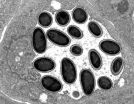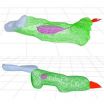(Press-News.org) A Rice University study of tamper-resistant voting methods revealed that only 58 percent of ballots were successfully cast across three voting systems. The researchers concluded additional work is needed to make voting both secure and user-friendly.
The study, "Usability of Voter Verifiable, End-to-End Voting Systems: Baseline Data for Helios, Prêt à Voter and Scantegrity II," examined three new end-to-end voting systems – systems that give voters the option to both verify the system is working properly and to check that their votes have been recorded after leaving the polling place.
Claudia Acemyan, a postdoctoral fellow at Rice and the study's lead author, said voting concerns such as accuracy, privacy and bribery/coercion have prompted research and development of ways to make voting tamper-resistant and verifiable by voters. She said that while the three systems evaluated solved many of the security problems surrounding voting with traditional methods – such as voters being able to independently confirm that a vote was counted correctly – the systems' added complexity appeared to negatively impact their usability.
"Overall, the tested systems were exceptionally difficult to use," Acemyan said. "Our data revealed that success rates of voters casting ballots on these systems were extraordinarily low – specifically, only 58 percent of ballots were successfully cast across all three systems."
The research also revealed that using the three voting systems took twice as long as traditional voting systems. The three systems studied were Helios, a Web-based voting system; Prêt à Voter, a system that allows voting with paper forms that are scanned after they are filled out by voters; and Scantegrity II, an optical scan voting system that enables someone to vote with a specially designed paper bubble ballot. Challenges ranged from voters having to complete new, confusing voting procedures that deviated from what they currently do to cast a vote, to voters having to use equipment with which they are unfamiliar.
"If voting is more time-consuming, then it might mean more people will have to wait in longer lines and election officials might need to purchase more equipment," Acemyan said. "And if indivdiuals are unable to complete the voting process, it can impact the outcome of elections."
Acemyan said that voting-system developers must be mindful of different types of voters and their level of comfort with technology and unfamiliar procedures.
"When designing voting systems, you must keep the diverse population in mind – otherwise you have the potential to disenfranchise voters and change election outcomes," Acemyan said. "Voting security is important, but there needs to be a way for it to happen behind the scenes. It should not require additional effort on the voter's behalf."
The study of the three voting systems included 37 participants (22 male, 15 female) who were U.S. citizens at least 18 years of age. Thirty-eight percent of the participants were African-American, 27 percent Caucasian, 11 percent Mexican-American/Chicano, 11 percent Hispanic/Latino and 13 percent other ethnicities. The majority of participants – 62 percent – completed some college or had an associate's degree, 5 percent had a high school diploma or GED, 22 percent had a bachelor's degree or equivalent and 11 percent held a postgraduate degree. Participants had normal or corrected-to-normal vision and had, on average, voted in 5.1 state and local elections. Volunteers rated their computer expertise on a scale from one to 10, with one being novice and 10 being expert; the average was 8.2.
Acemyan said that she hopes the research will encourage further improvements in end-to-end voting systems.
INFORMATION:
Rice psychology professors Phil Kortum and Mike Byrne and Rice computer science professor Dan Wallach co-authored the study, which appeared in a recent edition of the Journal of Election Technology and Systems. The study is available online at http://bit.ly/1yhOrqE.
Study: Only 58 percent of votes cast on tamper-resistant systems counted
2014-10-14
ELSE PRESS RELEASES FROM THIS DATE:
Swiss scientists explain evolution of extreme parasites
2014-10-14
Extreme adaptations of species often cause such significant changes that their evolutionary history is difficult to reconstruct. Zoologists at the University of Basel in Switzerland have now discovered a new parasite species that represents the missing link between fungi and an extreme group of parasites. Researches are now able to understand for the first time the evolution of these parasites, causing disease in humans and animals. The study has been published in the latest issue of the scientific journal Proceedings of the National Academy of Sciences (PNAS).
Parasites ...
Spinal cord injury victims may benefit from stem cell transplantation studies
2014-10-14
Putnam Valley, NY. (Oct. 13, 2014) – Two studies recently published in Cell Transplantation reveal that cell transplantation may be an effective treatment for spinal cord injury (SCI), a major cause of disability and paralysis with no current restorative therapies.
Using laboratory rats modeled with SCI, researchers in Spain found in laboratory tests on cells harvested from rats - specifically ependymal progenitor cells (epSPCs), multipotent stem cells found in adult tissues surrounding the ependymal canal of the spinal cord - responded to a variety of compounds ...
Treating cancer: UI biologists find gene that could stop tumors in their tracks
2014-10-14
The dirt in your backyard may hold the key to isolating cancerous tumors and to potential new treatments for a host of cancers.
University of Iowa researchers have found a gene in a soil-dwelling amoeba that functions similarly to the main tumor-fighting gene found in humans, called PTEN.
When healthy, PTEN suppresses tumor growth in humans. But the gene is prone to mutate, allowing cancerous cells to multiply and form tumors. PTEN mutations are believed to be involved in 40 percent of breast cancer cases, up to 70 percent of prostate cancer cases, and nearly half of ...
How metastases develop in the liver
2014-10-14
This news release is available in German. In order to invade healthy tissue, tumor cells must leave the actual tumor and enter the bloodstream or lymphatic system. For this purpose, they use certain enzymes, proteases that break down the tissue surrounding the tumor, thus opening the way for tumor cells to reach blood or lymphatic vessels. To keep the proteases in check, the body produces inhibitors such as the protein TIMP-1, which thwart the proteases in their work.
But during development of metastases, the control function of this inhibitor appears not only to ...
Size of minority population impacts states' prison rates, Baker Institute researcher finds
2014-10-14
HOUSTON – (Oct. 13, 2014) – New research from Rice University's Baker Institute for Public Policy found that states with a large minority population tend to incarcerate more people.
According to lead author Katharine Neill, states with large African-American populations are more likely to have harsher incarceration practices, worse conditions of confinement and tougher policies toward juveniles compared with other states. She said these findings provide some support for long-standing arguments among sociology and criminal justice experts that the criminal ...
Uncertain reward more motivating than sure thing, study finds
2014-10-14
Recently, uncertainty has been getting a bad rap. Hundreds of articles have been printed over the last few years about how uncertainty brings negative effects to the markets and creates a drag on the economy at large. But a new study appearing in the February 2015 edition of the Journal of Consumer Research finds that uncertainty can be motivating.
In "The Motivating-Uncertainty Effect: Uncertainty Increases Resource Investment in the Process of Reward Pursuit," Professors Ayelet Fishbach and Christopher K. Hsee of the University of Chicago Booth School of Business and ...
Inside the Milky Way
2014-10-14
Is matter falling into the massive black hole at the center of the Milky Way or being ejected from it? No one knows for sure, but a UC Santa Barbara astrophysicist is searching for an answer.
Carl Gwinn, a professor in UCSB's Department of Physics, and colleagues have analyzed images collected by the Russian spacecraft RadioAstron. Their findings appear in the current issue of The Astrophysical Journal Letters.
RadioAstron was launched into orbit from Baikonur, Kazakhstan, in July 2011 with several missions, one of which was to investigate the scattering of pulsars ...
PTPRZ-MET fusion protein: A new target for personalized brain cancer treatment
2014-10-14
Researchers at the University of California, San Diego School of Medicine have identified a new fusion protein found in approximately 15 percent of secondary glioblastomas or brain tumors. The finding offers new insights into the cause of this cancer and provides a therapeutic target for personalized oncologic care. The findings were published this month in the online edition of Genome Research.
Glioblastoma is the most common and deadliest form of brain cancer. The majority of these tumors – known as primary glioblastomas – occur in the elderly without evidence ...
Researchers say academia can learn from Hollywood
2014-10-14
HOUSTON, Oct. 13, 2014 – According to a pair of University of Houston (UH) professors and their Italian colleague, while science is increasingly moving in the direction of teamwork and interdisciplinary research, changes need to be made in academia to allow for a more collaborative model to flourish.
Professors Ioannis T. Pavlidis and Ioanna Semendeferi from UH and Alexander M. Petersen from the IMT Lucca Institute for Advanced Studies in Italy published a commentary in the October 2014 issue of Nature Physics, articulating policies that will harmonize academic ...
University of Tennessee study finds crocodiles are sophisticated hunters
2014-10-14
Recent studies have found that crocodiles and their relatives are highly intelligent animals capable of sophisticated behavior such as advanced parental care, complex communication and use of tools for hunting.
New University of Tennessee, Knoxville, research published in the journal Ethology Ecology and Evolution shows just how sophisticated their hunting techniques can be.
Vladimir Dinets, a research assistant professor in UT's Department of Psychology, has found that crocodiles work as a team to hunt their prey. His research tapped into the power of social media ...



